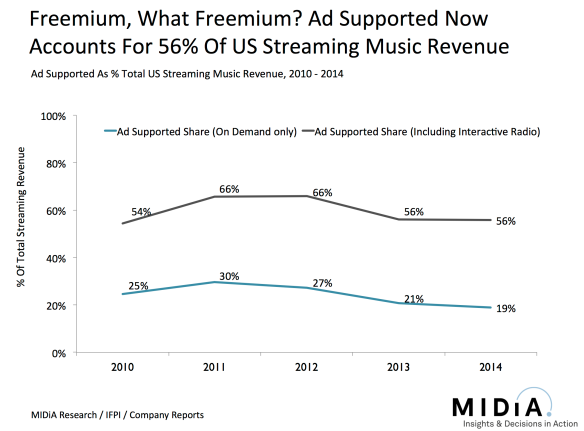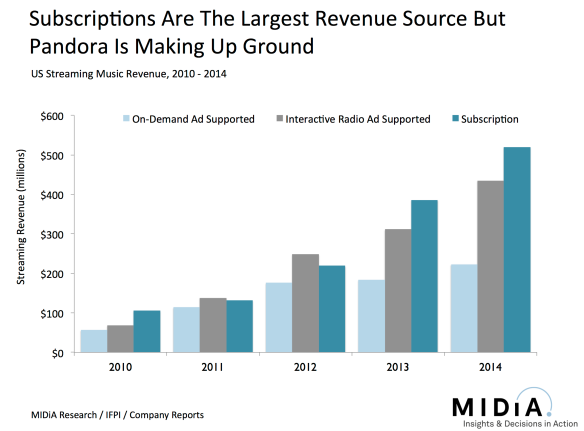Late 2014 a minor crisis emerged in the music industry, with major record labels at one stage looking like they were going to kill off freemium. The outcome of the Freemium Wars was actually less dramatic, resulting instead in an effective continuation of the status quo. The labels had however made it very clear to Spotify who held the whip hand. Though their tones have softened, major label execs retain an at best sceptical view of free streaming. The net result is that freemium has almost become the inconvenient streaming truth that no one really talks about. However free is too big to ignore. In fact free is much bigger than some would like to admit.
According to the IFPI ad supported streaming accounted for just 19% of all US streaming revenues in 2014, down from a high of 30% in 2011. Which points to the success of subscriptions. Except that those numbers ignore a major part of the equation: Pandora (and other semi-interactive radio services). The IFPI has Pandora hidden away with cloud locker services, SiriusXM and a mixture of other revenues in ‘Other Digital’. Extracting the semi-interactive radio revenues that count as label trade revenues wasn’t the most straight forward of tasks but it was worth the effort. Once Pandora is added into the mix it emerges that 56% of US streaming revenues are from free, ad supported services. While that share is down from a high of 66% in 2012 it remained flat in 2013 and 2014. Which means that however fast subscriptions grew Pandora, Slacker, Rhapsody UnRadio and co grew even faster in order to offset the decline in on demand ad supported income.
Semi-interactive radio revenues grew by 40% in 2014 compared to 35% for subscriptions. Subscriptions had grown much faster in 2013 (76% compared to 25%) but Pandora and co found their mojo again in 2014. None of this is to suggest that subscriptions aren’t making great progress but it does show us that free is more than an inconvenient truth, it is both the most widely adopted behaviour and the largest revenue source in the US (which accounts for 48% of global digital revenues).
The music industry is beginning to get its head around the fact that the role of streaming as a retail channel (i.e. subscriptions) is always going to be smaller (in reach terms at least) than its role as a radio channel (i.e. free streaming). This more accurate view of the US streaming market shows us that free is even more important than many thought.
Free streaming also has much bigger growth potential. The percentage of consumers that have the inclination to pay 9.99 a month for music is inherently limited, thus constraining subscriptions to a niche addressable audience. Music radio listening by contrast has near ubiquitous reach. Most significantly Pandora currently only represents about 10% of all US radio listening time. The addressable market is much bigger and the vast majority of it remains untapped.



I’m assuming that you included paid semi-interactive radio subscriptions on the streaming subscription side of the ledger, yes?
Impressive revenue growth, but a few reservations:
a) Pandora are already trying to drive down their royalty rates by legal action
b) internet advertising rates generally are falling. The ‘pot’ of advertising spend is relatively fixed, and advertisers will only put more of it into interactive radio if they think it is an effective medium, which is doubtful.
c) interactive radio cannibalizes other music media: download sales, on-demand streaming (paid or ad-supported), and broadcast radio. (Admittedly the latter doesn’t matter so much to record labels in the US, as broadcast radio doesn’t pay them anyway.) What the rapid growth in interactive radio seems to prove is that interactive radio is functionally a close substitute for on-demand streaming, which isn’t surprising, because that is how it is designed. Yet interactive radio enjoys the huge legal privilege of compulsory licensing and non-negotiated royalty rates. It is hard to see any justification for this. If Pandora had to compete on equal terms with on-demand streamers like Spotify, would they be showing the same growth rate, or more of that growth be going to the streamers?
Pingback: Ad Supported Is 56% Of US Streaming Revenue
kingsinger – yes indeed, all premium radio subscription revenue is stripped out and put in with AYCE subscription revenue.
David – you make some important points. The non-commercially rights aspect has some fascinating implications. Pandora built a hugely successful business with a hugely successful ‘exit’ of compulsory licenses. So far, with the exception of Beatport and (only partially, in terms of licenses) Last.FM, no music service with compulsory licenses has made a proper high multiples exit in the 15 years or so of digital music’s history (and I’m not buying that Beats Music counts as one, that was deal sweetener). Compare and contrast with any other consumer tech sector (games, social, messaging etc.) where you see a steady stream of really high value exits. So we’re stuck between two 2 tensions: on the one hand compulsory licenses take the right of veto away from a rights holder and can result in too low royalties for creators, but commercial licenses leave too little margin for services to succeed.
Mark, this is a fantastic and interesting analysis. Just wondering in which column Sirius XM revenues are allocated? It is in the same class as Pandora — a digital broadcaster that operates under compulsory licenses and pays royalties to SoundExchange — but has over 25 million paying subscribers. Just curious because Sirius has been remarkably successful in attracting paying subscribers year over year, and I believe it is the first or second biggest contributor of funds to the SoundExchange royalty pool.
Pingback: Start up: ad traffic fraud, adblocking goes paid and free, US v Google?, BlackBerry to Android, and more | The Overspill: when there's more that I want to say
Pingback: Ad Supported Is Actually 56% Of US Streaming Revenue - South Carolina Music Guide
Pingback: TRENDS: Ad Supported is Actually 56% of Us Streaming Music Revenue | eventnewsdigest.com
Pingback: Land of the free? 5 myths about the American music market. – Music Business Worldwide | World Prime Trends
Pingback: LAND OF THE FREE? 5 MYTHS ABOUT THE AMERICAN MUSIC MARKET. | Find Your Sounds
Pingback: » Land Of The Free? 5 Myths About The American Music Market. AUDIO KORNER
Pingback: RIAA Misleads While Advertising Delivers 54% of Internet Radio Revenue
Pingback: Aurous, the ‘Popcorn Time for Music,’ Is Launching In Less Than Two Weeks - Danceamp
Pingback: Aurous, the 'Popcorn Time for Music,' Will Officially Launch October 10thDigital Music News - WorldArts
Pingback: The Top 10 Internet Radio Articles of 2015 | XAPP